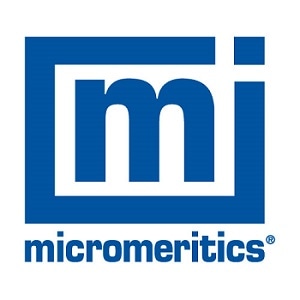Chemisorption is an established technique used to determine the active metal surface area using the chemical potential of the adsorbate-adsorbent interaction, and has been traditionally used to characterize catalyst metal surface areas.
Static measurement devices (often known as volumetric instruments) such as the Micromeritics ASAP 2020 or dynamic flow techniques as can be found in the Micromeritics AutoChem 2920 can be used to perform chemisorptions.
If the adsorbate-adsorbent interaction is well known, the chemisorption technique can produce reliable results. For instance, carbon monoxide is selectively chemisorbed on platinum with a stoichiometry of one to one, meaning one carbon monoxide molecule is chemisorbed to one surface atom of platinum. To chemisorb to metals, hydrogen can also be used as it is dissociatively chemisorbed to platinum, i.e., one hydrogen molecule chemisorbs with two platinum surface atoms.
Characterization of Copper Catalysts
The chemisorption technique has not been considered as effective in the characterization of copper catalysts. Neither carbon monoxide nor hydrogen has shown a strong chemisorption on copper. The classic approach for characterizing copper surface areas employs the decomposition of nitrous oxide to selectively oxidize the surface copper atoms to Cu2O with a stoichiometry of one oxygen atom to two copper surface atoms6,7, using the following reaction:
Sample pretreatment involves reduction of the copper surface with flowing hydrogen at a temperature range of 200-300 °C for 1-2 hours, followed by cooling the sample to the analysis temperature (60-90 °C) and introducing the pulses of nitrous oxide to selectively oxidize the copper surface. The nitrogen evolved from this reaction has been traditionally measured using a thermal conductivity detector (TCD).
Pulsed Chemisorption
The example provided in this article involved pulsing a mixture of 10% N2O in helium over copper supported on a zeolite substrate. The peaks of evolved N2 (Figure 1A) were measured using a TCD. Figure 1B shows the cumulative volume of evolved N2. An IPA/LN2 cold trap was used to remove any unreacted N2O.
An interesting feature of this characterization is the site-demanding nature of the reaction—two adjacent copper atoms are needed for catalysis. As illustrated in Figure 1, the first seven pulses of N2O reacted with 90% of the copper surface atoms. An additional four pulses (11 total) were needed to attain 95% surface coverage, and nine additional pulses (20 total) were needed to reach 99% coverage (Table 1). This site-demanding nature of copper characterization is characteristic of almost all chemical reactions, where more than one catalytic site is required.
Separating the evolved nitrogen from the non-reacted nitrous oxide is one of the challenging aspects of the pulse technique. The use of a TCD is limited to determining the changes in the concentration of one gas. The evolved nitrogen is typically separated from the N2O using a cold trap (liquid argon, dry ice slush, or isopropyl alcohol/liquid N2 slush). These are the renowned and widely accepted methods for measuring the evolved nitrogen gas, but employing a trap limits the experimenter to access only 50% of the available information. It is to be noted that this is a reactive technique for catalyst characterization and it is useful for monitoring nitrous oxide depletion as well as nitrogen production.
The combination of a mass spectrometer (MS) and the AutoChem 2920 delivers a versatile detector capable of providing continuous monitoring of reactants and products. Commercial residual gas analyzers usually deliver data in different formats. An analog scan or histogram is the most familiar mode where a user-defined mass range is scanned by the mass spectrometer.
However, monitoring specific ions (often referred to as amu, atomic mass units) or the partial pressure of user-specified ions is the most useful and convenient display mode for pulse reactions. A convenient implementation of this mode is to present the data as ion pressure vs. time, as shown in Figure 2. This data format is very similar to a TCD output, but offers the additional functionality of monitoring the concentration of different reactants and products.
N2O decomposition is a very simple reaction that demonstrates the utility of a mass spectrometer. The mass spectrometer and TCD signals agree well with the measurement of the evolved nitrogen, but the mass spectrometer possesses the additional capability of determining the unreacted pulses of nitrous oxide as the reaction proceeds.
It is possible to import the data produced by almost all commercial mass spectrometers into MicroActive for additional data reduction.
References and Further Reading
- J.R.Anderson, Structure of Metallic Catalysts, p. 323, Academic Press, New York (1975).
- R.M.Dell, F.S. Stone, and P.F. Tiley, Transactions of the Faraday Society, 49, 195 (1953).
- J.J.F. Scholten and J.A. Kon- valinka, Transactions of the Faraday Society, 65, 2465 (1960).
- B. Dvorak and J.J. Pesek, Journal of Catalysts, 18, 108 (1970).
- Th.J. Osinga, B.G. Linsen, and W.P. van Beek, Journal of Cataly- sis, 7, 277 (1967).
- K. Narita, N. Takezawa, H. Kobayashi, and I. Toyoshima, Reac- tion Kinetics and Catalysis Letters, 19, 91 (1982).
- T.S. King, W.J. Goretzke, and B.C. Gerstein, Journal of Catalysis, 107, 583 (1987).

This information has been sourced, reviewed and adapted from materials provided by Micromeritics Instrument Corporation.
For more information on this source, please visit Micromeritics Instrument Corporation.